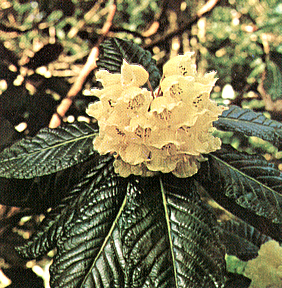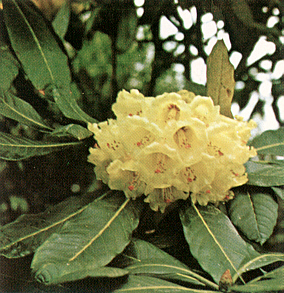Large Leafed Species in Britain
John D. Johnston, Asheville, N.C.
East meets West on the southerly slopes of Cornwall, and it was here that we found growing in profusion the large leafed rhododendron species that are native to the Himalaya. Here are the great estates whose owners financed the expedition of Joseph Hooker to China in 1849, and through succeeding expeditions to Forrest in 1911. And here we saw the arboreums and sinograndes from seed that they brought back to England, now blooming as though in their native rain forests.

|
|
R. sinogrande
; taken at Caerhays
Cornwall, England Photo by John D. Johnston |
The high spot of our trip was undoubtedly Caerhays Castle, home of Mr. and Mrs. F. Julian Williams. On the steep hillsides rising from the sea we were overwhelmed by the size and beauty of the
sinograndes
with masses of creamy florets and dark green shiny leaves two feet long. Each turn of the path revealed a glorious sight:
R. keysii
, pink
R. argenteum
,
Magnolia sprengeri
,
R. eriogynum
hybrid, and beautiful red hybrids - 'Mrs. Butler', 'Elizabeth', 'The Admiral' - to name only a few. The ultimate was a Caerhays cross of
R. falconeri
x
sinogrande
, that proved to be a great truss of surprising pale pink florets. The usual downpour sent us scurrying into the Castle where the hospitable, young, and personable Williams charmed us with tea.
April of 1970 provided us with rain every day, but that did not prevent our enjoyment of the gardens, nor interfere with photography. We had the good fortune to have Frank and Helen Knight as traveling companions, and Frank, retired director of the Royal Horticultural Society Gardens at Wisley, masterminded our tour, as well as introducing us to his gardening friends. Our base of operations was the delightful Rising Sun at St. Mawes, Cornwall.
At the head of the Fal Estuary is the imposing Tregothnan, built in 1650, the home of Viscount and Viscountess Falmouth. The grounds are extensive and the lawns a perfect setting for the immense
arboreums
that include every shade from white to the ox-blood red that is the pride of the estate and is used so much in hybridizing. Here we saw the parent
arboreum
from seed brought from China by Hooker in 1850, about 45 feet in circumference, as well as a forest of tree ferns and palms. Our hosts posed for a picture in front of a large
R. calophytum
tree that was a mass of pale blooms.
The emphasis at adjoining Trelissick is on hybrids, and Mr. Jack Lilly has grown some stunning ones. 'Dot' is a gorgeous pink truss with deeper pink buds, 'Diane' is cream with dots like irroratum, 'Trelissick Salmon' an unusual shade, 'Bill's Triumph' a true fiery red, and 'Wilhelmina' a shapely shrub which was a mass of striking red blossoms.
|
|
It was at Trengwainton in 1969 in the month of May that we saw the new growth on the large leafed rhododendrons and determined to return for the bloom. So here we were in April 1970, back at Trengwainton, speechless before their FCC
macabeanum
, their A. M.
sinogrande
,
argenteum
,
grande
,
eximium
(white with pink stripes), bright red
neriiflorum
, and single and double
johnstoneanum
. Here also we saw the choicest small rhododendron species: the
spinuliferum
that is the size of a cigarette, and the rare blue
genestierianum
brought from Tibet by Forrest in 1912.
Mrs. Johnstone, president of the Cornwall Garden Society, and her daughter, Elizabeth, received us most hospitably at Trewithen, their beautiful home built in 1723. They showed us the definitive book on Chinese magnolias written by the late Major Johnstone. Their garden was a riot of color with a profusion of Camellias, Chinese magnolias of every color, as well as fine specimens of
macabeanum
(from seed, 1908), and FCC
sinogrande
(1919). Also a fine collection of
R. pemakoense
,
yunnanense
, and
chrysomanicum
.
Major Magor was busy packing rhododendron blooms to send to Covent Garden, but he graciously showed us around his estate, Lamellon. Among his outstanding plants were 'Dr. Stocker',
irroratum
, 'Robert Kier', 'Red Admiral', and the original plant of 'Damaris', named for his sister.
Major-General Harrison has a lovely formal garden surrounding his home, Tremeer, and has many crosses to his credit. He took a First at both Truro and London shows with 'Robert Kier'. Here we saw the best
R. niveum
of the trip, 'Fortune' in full bloom and a magnificent 'Barclayi'.
Mr. Nigel Holman has a beautiful estate, Chyverton, with stream, lawns, and woodland garden. His
R. fulvum
was unusually fine, as well as a
ciliatum
that was a mass of blooms and a lovely blue
scintillans
.
Commander and Mrs. J. C. Williams and their son, Rob, entertained us at luncheon at Werrington Park, their magnificent home that is part Elizabethan and part Queen Anne, and nowhere more than one room thick. Across the deer park and stream, and up on the hillside, we found a typical rain forest where there were more of Forrest's seeds from Burma and Yunnan planted than anywhere else in the United Kingdom. Here is a grove of
R. sutchuenense
that now have branches 4 inches thick; seedlings of
R. lacteum
as well as crosses; moss trunks of
R. calophytum
; the darkest ever
arizelum
rubrotinctum
;
sanguineum
, a bullock's-blood red; and the finest example of
meddianum
. Commander Williams and Mr. George Frye, their long-time gardener (and since deceased) knew the history of each species. This was an unforgettable experience for us, scrambling over a hillside that might have been lifted from the Far East.
A true adventure is the trip to the Scilly Isles, which are 40 miles off the Cornish coast and which are reached by helicopter and connected by motor launch. The gardens of Tresco are planted around the ruins of an old monastery, and are famed for the rare plants growing in the open on this bleak wind-swept island. We were impressed by the giant blue echiums from the Canary Islands, yellow cytisus from Madeira, erica from South Africa, tree dandelions, and every variety of mimosas. The museum of ship's figureheads was fascinating, as over a thousand ships have wrecked on these rocky isles. Most interesting of all was Commander Dorrien-Smith, six feet six and about 260 pounds of hearty, affable man of the sea, who holds the island of Tresco on lease from the duchy of Cornwall and who has done much to improve the lot of its 180 inhabitants.
In Devon we visited the garden at Knightshayes, magnificent home of Sir John and Lady Amory. They were most gracious and entertained us at tea and dinner. Their garden is the formal type with terraces, topiary, alpine plants, and paths of spring flowers interspersed with unusual dwarf rhododendrons.
In Sussex we were fortunate to be able to join the Rhododendron group of the Royal Horticultural Society on a personally conducted tour of Nymans and Leonardslee. Sir Giles and Lady Loder are most charming and knowledgeable, and are justly recognized for their important work in rhododendron culture. They invited us to lunch at Leonardslee and then showed us their garden. Of especial interest was the original Loderi, now 25 feet tall and with branches 4 inches thick. Some of their hybrids. 'Seamew' and 'White Glory', were in beautiful bloom. The camellias were very choice, especially the ones in the glass house. There was an extensive azalea planting with waterfall and many dwarfs and alpines were arranged in a natural rock garden.

|
|
Fig. 8. Sir Giles and Lady Loder in their garden at
Leonardslee, Sussex, England Photo by John D. Johnston |
It did not rain the week we were in Scotland. It snowed, and the blooms were magnificent. We were intrigued with Brodick Castle Garden, on the Isle of Arran, which we reached by ferry off the west coast of Scotland. Mr. John Basford is in charge of the garden and showed us some of the large leafed rhododendrons too tender to grow anywhere else in the northern hemisphere. (It doesn't quite freeze in Arran.) The drive to castle was lined with
R. magnificum
in full bloom. We saw
R. macabeanum
,
R. arizelum
A.M., and the original plant of
R. mollyanum
, as well as a fine
R. lutescens
in glorious yellow. The Basfords served us a delicious tea with Scotch shortbread while the snow came down.
About 40 miles away on the mainland is Glenarn. a treasure trove of unusual rhododendrons. Many are being layered, by air and ground. We saw probably the largest
R. thomsonii
tree in full bloom, about 20 feet tall. Also the loveliest
R. strigillosum
, a perfect mound about 8 feet tall in shiny red bloom with tight leaves, and the finest
R. griffithianum
.
As though Frank Knight had not done enough already, he shepherded me through the Rhododendron show of the Royal Horticultural Society at London as it was being set up. Then he got me a seat on the sidelines at the meeting of the Rhododendron Committee, with Sir Giles Loder as chairman, where the awards were made. An F.C.C. was awarded 'Galactic' from Exbury, which plant also won best truss in the show.
Their shows are different from ours in many ways. For one thing various nurseries put on a marvelous display of growing plants, and vie for an award. Then, the main accent is on species. The most coveted award is for a group of six species. Hybrids are grouped according to parentage. A branch of four trusses is featured and makes a good display. The Truro Show is a week earlier than the London Show, and is held in high regard for the quality of its blooms. Commander Dorrien-Smith and Mr. Julian Williams had extensive exhibits not in competition there.
This account has been written as a labor of love to express our appreciation to our hosts and hostesses who gave us such a warm and genuine welcome. While the memory of the bloom lingers on, we find that the regard for the friends we met is ever fresher.

